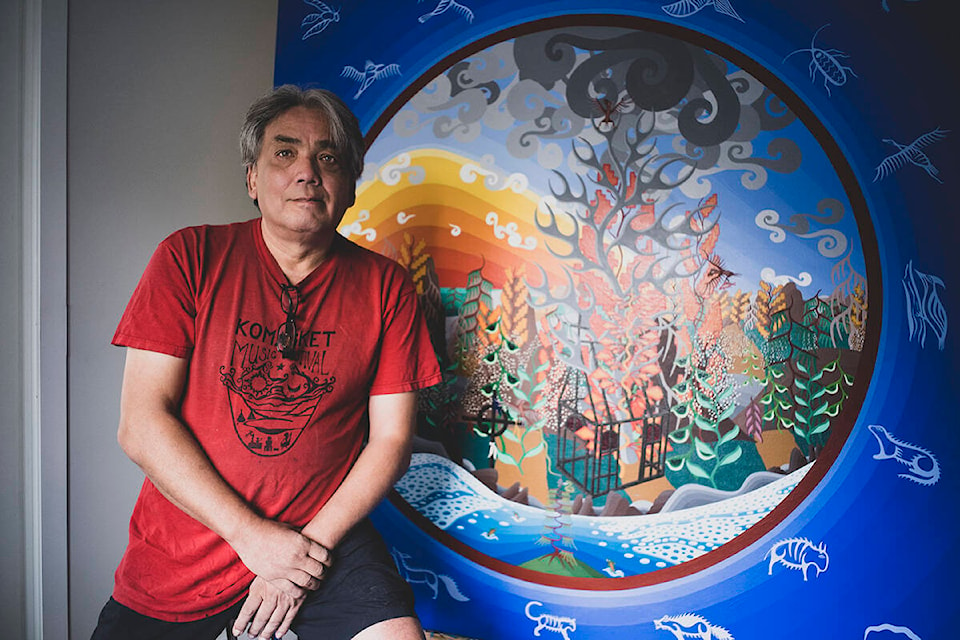- Words by David Wylie Photographs by Lia Crowe
David Wilson Sookinakin’s search for meaningful art began in elementary school.
As member of the Syilx Okanagan Nation, he wanted to find works that represented his own cultural identity.
“I remember wondering where our art was,” said David. “I just wanted to find art that I could identify with.”
He searched libraries for Indigenous artwork, and found only totem poles and Inuit art. He eventually explored the Vernon Museum’s archives and found roots of his Interior Salish culture in centuries-old pictographs documented in anthropology books.
“That was the art of my ancestors,” he said.
David returned to the archives to view the pictures until he was about 18. Wanting to bring the images out of the archives and into the art world, he went to Langara College in the 1990s to study business, while learning from Coast Salish and Haida artists in his free time.
A decade after leaving for the Lower Mainland, he returned to Vernon.
“I didn’t feel comfortable continuing the West Coast totem pole art because I’m not from there,” he said. “So I went back to the museum and found the pictographs that were still in the archives. I photocopied them and I used the skills that I learned from the West Coast art and transferred them to the pictographs.”
Indigenous elders didn’t want pictographs copied exactly, preferring artists be inspired by them.
David’s interpretation is a colourful, clean, crisp and modern style. His work draws on the symbols and stories of Okanagan First Nations heritage and culture. He was inspired locally by Barry Brewer, creator of the Okanagan Indian Band’s porcupine logo.
David uses vibrant acrylic colours with a surreal graphic style, making use of geometric and organic shapes.
“If we just copy them, they’re not evolving; they’re exactly what they were 200 years ago. We need to take it farther, evolving the art from an anthropology book item to a piece of art,” he said. “I’m trying to bring the style out.”
David has created nearly 50 four-legged-animal pictographs in his unique style, which has evolved over the years from simple pictographs to ones that include complex background scenes, which tell their own stories and motifs.
“It’s taken me quite a while to start to understand what I want to do,” he said.
His works cover various surfaces and mediums, including canoes, drums, canvas and wood, as his art explores traditional ways of Interior Salish People, often captured within traditional circle forms.
“It’s part of the native spirituality, everything is a circle—a belief that in a circle there’s no beginning and no end,” he said.
David’s paintings often portray familiar Okanagan landscapes and wildlife. He’s incorporated Okanagan Lake’s mythical sea monster, Ogopogo, based on his family’s own experiences. His mother and sister have had sightings of the creature while sitting at their family cabin along the west side of Okanagan Lake, he says. They described the creature as brown with green dots, and with a horse-like head—and that’s how David has portrayed it.
His painting Spotted Lake is one that resonates deeply with the Okanagan People. Located near Osoyoos, the lake is said to be medicinal. There are about 365 circles in the lake, and each one represents a day of the year.
“A long time ago, people used to go there for healing. They would camp by the lake. During the night they’d receive a dream and be instructed or directed to a certain hole. The person would take some mud and it would be like a salve. They’d apply it as part of the healing,” he said.
At one time, the lake was privately owned. The Okanagan People lobbied the government, which purchased the lake and gave it back to the People.
David tries to give back what he himself missed. He works regularly in Okanagan schools, including Beairsto Elementary in Vernon (which he attended years ago), to teach and inspire children. David has painted murals in nearly every school in Vernon, and he is designing logos for BX Elementary School sports teams. There is also a painted 26-foot cottonwood canoe on display at Clarence Fulton Secondary School—a project completed by David and two of his relatives.
“Any time that I go back into schools, I remember that I was at one time looking for art that I could find identities through,” he said. “When I go back to the schools, I find that I was once the child looking for art but now I’m the teacher. For me, it’s like coming full circle.
“I remember as a youth how much I wanted to identify through art. It’s an art form that they can call their own. Now they have it. Hopefully they will make it their own.”
David’s work is published and exhibited in various galleries and public spaces throughout the Okanagan Valley and the Lower Mainland. It’s also been displayed at Kelowna International Airport.
David is about to be featured for the first time on the international stage. His works have been chosen to be featured in Transform LA, a group exhibit to be held in November—which is Native American Heritage Month—at the Official Residence of Canada in Los Angeles. It’s a showcase for Indigenous artists local to Canada and southern California for an audience of business leaders, artists and agents of change.
Story courtesy of Boulevard Magazine, a Black Press Media publication
Like Boulevard Magazine on Facebook and follow them on Instagram



